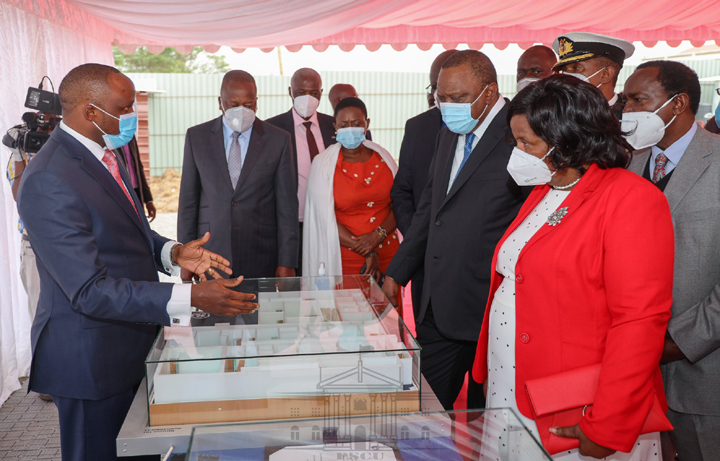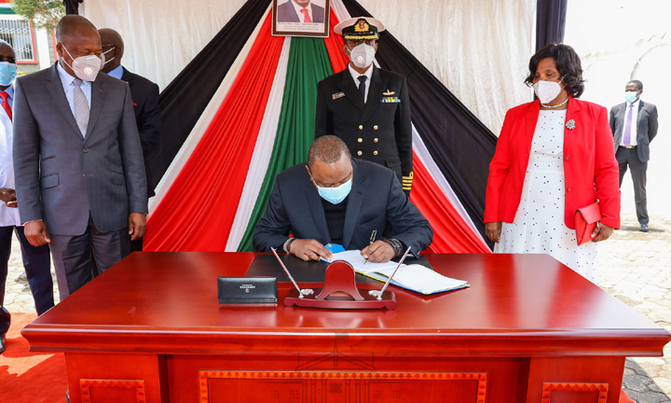Work on East Africa’s first comprehensive cancer treatment center begins
Cancer patients in East Africa Community will soon access advanced cancer care at affordable cost following the recent signing of a contract between Kenyatta University Teaching, Research and Referral Hospital (KTTRH), and General Electric (GE) to set up an Integrated Molecular Imaging Centre (IMIC).
The hospital which was commissioned by Kenyan President Uhuru Kenyatta on September 10, is set to host the first public sector comprehensive cancer centre in East and Central Africa. The hospital’s inauguration marks a significant milestone in the health sector and is a part of Kenyatta’s Big Four Agenda that prioritises increased access to quality and affordable healthcare to achieve Universal Health Coverage (UHC).
KUTRRH’s vision of having a world-class University Hospital in Kenya was conceived in 2008. The modern 650-bed state-of-the-art facility includes 76-bed cancer (oncology) centre, renal unit, cardiology, physiotherapy, and many other specializations was born. It is also the first hospital to operationalise the pure referral model meant to be for highly specialised and emergency cases.
The inauguration was also marked by President Kenyatta laying a foundation stone for an Integrated Molecular imaging Centre (IMIC) and Hospitality Centre. The IMIC is a unique facility for the early diagnosis and monitoring treatment of cancer, being equipped by GE Healthcare.
Kenyatta University Teaching, Research and Referral Hospital is poised to become the only public facility in East and Central African region to offer the comprehensive continuum of cancer care with the establishment of an Integrated Molecular Imaging Cancer diagnostic and Treatment Centre coupled with a Hospitality Centre.
Kenyatta observed that the ultra-modern hospital including a 20-bed renal unit is at par with leading hospitals in the world.
“With this oncology centre, which is one of its kind in the region, the hospital is able to provide early diagnosis and possible management options of cancer and renal diseases. I am informed this will greatly reduce costs and significantly boost recovery rates of our (cancer) patients,” he said.
Kenyatta further noted that cancer is a key research area that is still lagging behind in the region and thus it is hoped the existence of the centre will spur leadership in the research of cancer across the region to bring the most promising cancer care.
The American Conglomerate, General Electric Healthcare will equip the centre with molecular imaging equipment including PET CT to create 3D pictures of the inside of the body and help show up areas of cell activity SPECT CT, which helps show the blood flow to tissues and organs and can help show tumours, and MRI scanners, as well as a Cyclotron so that KUTRRH can create its own radioisotope imaging agents.
In addition, GE will partner with KUTRRH to provide specialised, on-the-job training for the cancer centre team over an 18-month period.
The molecular imaging centre will complete KUTRRH’s 76-bed Comprehensive Cancer Centre which carries out radiotherapy and chemotherapy treatment. KUTRRH also looks forward to seeing this new centre enable research projects into cancer across the region.
According to the International Agency for Research on Cancer (IARC), there were 18.1m new cases of cancer and 9.6m deaths globally in 2018. IARC also reported the rapid emergence of cancer as a critical public health problem in Africa.
In 2018, there were 1.05m new cases and 693,000 deaths in Africa. However, in 2014 the numbers had been projected to nearly double (1.28m new cancer cases and 970,000 cancer deaths) by 2030 in Africa due to ageing and growth of the population. The current data indicates that the projections in 2014 have been surpassed.

With an increase in life expectancy, changes in diet and lifestyle, and lower incidence of communicable diseases, the cancer burden in Africa is slated to only increase over the coming years.
Despite this growing burden, cancer continues to receive low public health priority in Africa, largely because of limited resources and other pressing public health problems, including communicable diseases such as HIV/AIDS, malaria, and tuberculosis.
Cancer burden
For instance, in Kenya, with a population of 47m as per the 2018 Globocan data, cancer ranks third as a cause of death after infectious diseases and cardiovascular diseases.
In 2018, there were about 47,887 new cancer cases and 32,987 cancer deaths in Kenya. This translates to about 70% of deaths which means only 30% of those sick survived. With the Globocan estimates, 2 out of every 3 Kenyans diagnosed with cancer perish due to the disease. Over 60% of those affected are below the age of 70 years. The same remains true for most Sub Saharan countries
Currently, within the East African region, there is only one Comprehensive Cancer centre in Kenya at Aga Khan University Hospital, Nairobi. This is a private centre therefore not within reach of many Kenyans. With the establishment of KUTRRH as a national referral hospital and the establishment of Integrated Molecular Imaging Centre, KUTRRH is set to be the first public comprehensive cancer centre not only in Kenya but also in the region. This will lead to an improvement in capacity to handle cancer cases within the country and the region.
There is a growing interest from private healthcare providers as well as by the government and public sector institutions in this field and hence the number of patients receiving quality care is expected to increase over the next five years.
However, to address this growth, improved access to diagnostics and radiotherapy capabilities are needed. East Africa in general has extremely low levels of PET/CT and SPECT/CT penetration and less than twenty radiotherapy equipment across the region. This coupled with the limited availability of Oncologist/specialist, is restricting access to cancer care for the majority of the patients.
The World Health Organisation defines a comprehensive cancer centre as that which has a cancer control plan with the following components: prevention, screening, diagnosis, treatment, survivorship, and palliative or end-of-life care.
Speaking at the event, Mutahi Kagwe, CS Health said: “For years, most patients have been seeking cancer treatments in places like India, South Africa, and Dubai spending an estimated Ksh10b annually. We are certain this comprehensive cancer centre will be a huge relief and life-saving facility to many especially in the era of COVID-19. The addition of the Integrated Molecular Imaging Centre will bring the KUTRRH Cancer Centre to the levels defined by WHO covering all the requisite cancer centres.”
According to Prof Olive Mugenda, chairperson KUTRRH, one of the hospital’s flagship projects is the Comprehensive Cancer Care aimed at filling the cancer care gap in the country. Since operationalisation of the hospital in October 2019, 4,737 cancer out-patients and 686 in-patients have been attended to in the facility.
“We are delighted to be partnering with Kenyatta Hospital to create the largest public cancer screening diagnosis and treatment centre in Kenya and this region,” said Farid Fezoua, President and CEO of GE Africa.
“Cancer may be treatable if it is detected early, and we hope that this centre will increase the accessibility of comprehensive cancer care for patients, enabling earlier diagnosis, a better understanding of individual cancers via improved imaging, and staging capabilities for better and early treatment of cancers in Kenya.”
He added that as a long-standing partner to Kenya the company was committed to helping the country elevate the access and standard of cancer care in the country.
There are only two LINAC machines (radiotherapy treatment equipment) in Kenya’s public hospitals. One is at Kenyatta National Hospital and the other at KUTRRH. The LINAC machine at KUTRRH (CLINAC iX) is one of the latest Radiotherapy treatment equipment with a 3D treatment and Intensity Modulated Radiation Therapy (IMRT) capability, a highly specialised mode of treatment.
The current radiotherapy machine is already being utilised to its full capacity, with 50 to 60 patients receiving treatment daily and patient queues are to piling up with growing needs of care. An extra LINAC machine will double the capacity for radiotherapy from the current average of 60 patients daily to 120 per day.
Prof. Mugenda said with the laying of a foundation stone for an Integrated Molecular imaging Centre, Kenya is strategically placed to become a hub for medical tourism in East Africa.
To address the challenge of a limited specialised human resource capacity, Prof Mugenda informed the gathering that a training and knowledge transfer programme will be established that will ensure that the centre is staffed by highly specialised personnel, while at the same time positioning KUTRRH as a regional centre of excellence in oncology.
Source: New Vision
Support families fighting financial toxicity of cancer –here
